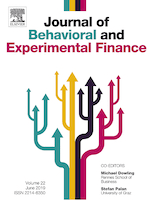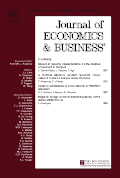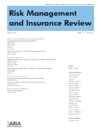
Decisions in Economics and Finance
Scope & Guideline
Exploring Innovative Solutions in Economics
Introduction
Aims and Scopes
- Economic Decision-Making Models:
The journal emphasizes the development and analysis of models that describe decision-making processes in economics, including game theory, stochastic control, and optimization techniques. - Financial Risk Assessment and Management:
It covers research related to the assessment and management of financial risks, particularly through innovative frameworks that integrate stochastic processes and actuarial science. - Investment Strategies and Portfolio Optimization:
The focus includes optimal investment strategies, portfolio management, and the application of advanced quantitative methods to enhance decision-making in finance. - Insurance and Pension Economics:
Research on insurance products, pension schemes, and actuarial practices is core to the journal, emphasizing the economic implications and risk management aspects. - Environmental and Sustainability Economics:
The journal also explores the intersection of economics with environmental concerns, focusing on sustainable practices and policies in economic decision-making. - Behavioral Economics and Decision Theory:
It investigates how psychological factors influence economic decisions, integrating insights from behavioral economics into traditional economic models.
Trending and Emerging
- Dynamic Stochastic Models:
There is an increasing emphasis on dynamic stochastic models that incorporate uncertainty and time-varying parameters, reflecting the complexities of real-world economic and financial systems. - Machine Learning and AI Applications:
The rise of machine learning and artificial intelligence in economic modeling and financial forecasting is a prominent trend, showcasing the journal's commitment to integrating cutting-edge technologies into traditional frameworks. - Behavioral Insights in Finance:
Research exploring behavioral aspects of finance, including cognitive biases and decision-making processes, is gaining prominence, indicating a shift towards understanding the psychological components of economic behavior. - Sustainable and Green Finance:
Emerging themes related to sustainability, environmental economics, and green finance are increasingly featured, reflecting the growing importance of these issues in economic decision-making. - Cryptocurrency and Blockchain Analysis:
The journal has seen a surge in research focusing on cryptocurrencies and blockchain technology, highlighting their implications for financial markets and economic systems.
Declining or Waning
- Traditional Financial Instruments:
Research focusing on classical financial instruments such as bonds and basic derivatives has been declining, as more innovative and complex financial products take precedence in the literature. - Static Economic Models:
There appears to be a waning interest in static models of economic behavior, with a shift towards dynamic models that incorporate time-dependent factors and stochastic elements. - Generalized Economic Theories:
The journal has seen a decrease in papers that discuss generalized or broad economic theories, possibly due to a preference for more applied and specific research topics. - Historical Perspectives on Economic Models:
Papers that focus solely on historical analysis of economic theories or models have become less frequent, as contemporary applications and innovations dominate the discourse. - Simple Risk Models:
There is a noticeable decline in publications centered on simple risk models, with a growing preference for complex, multi-dimensional risk assessments that consider various influencing factors.
Similar Journals

Probability Uncertainty and Quantitative Risk
Fostering Interdisciplinary Dialogue on Probability and RiskProbability Uncertainty and Quantitative Risk, published by the American Institute of Mathematical Sciences (AIMS), is a distinguished open-access journal that has been contributing to the academic community since its inception in 2016. With a focus on the crucial interplay between probability, uncertainty, and quantitative risk assessment, this journal serves as a vital platform for researchers, practitioners, and students engaged in the fields of Applied Mathematics and Statistics. The journal's ranking in the Q2 category for both Applied Mathematics and Statistics and Probability reflects its growing influence and relevance, while its diverse scope encourages interdisciplinary studies. As a part of the Scopus database and maintaining a consistent publication pace through 2024, Probability Uncertainty and Quantitative Risk is essential for anyone looking to remain at the forefront of research in risk analysis and uncertainty modeling. Its commitment to open access since 2016 further enhances accessibility to cutting-edge findings, making it an indispensable resource for academics and industry professionals alike.

North American Journal of Economics and Finance
Fostering rigorous exploration in finance and economics.The North American Journal of Economics and Finance is a premier academic journal published by Elsevier Science Inc. since 1992, dedicated to advancing the field of economics and finance through rigorous research and scholarship. With an impressive impact factor and recognition in the Q2 category for Economics and Econometrics and Q1 for Finance as of 2023, this journal holds a significant position in the academic community, ranked #41 out of 317 in Finance and #100 out of 716 in Economics. The journal features high-quality, peer-reviewed articles that cover a broad range of topics, from theoretical frameworks to empirical analyses and practical applications. Though not an open-access platform, the journal provides valuable insights for researchers, practitioners, and students alike, promoting knowledge dissemination in the dynamic landscape of economic and financial studies. With its commitment to excellence, the North American Journal of Economics and Finance serves as an essential resource for those seeking to deepen their understanding of contemporary issues in these critical fields.

Journal of Behavioral and Experimental Finance
Unlocking Behavioral Insights for Financial InnovationJournal of Behavioral and Experimental Finance, published by Elsevier, stands as a premier outlet for groundbreaking research in the realm of finance, particularly focusing on the psychological and behavioral factors that influence financial decision-making. With an ISSN of 2214-6350 and an E-ISSN of 2214-6369, this journal has established itself within the top tier, achieving a Q1 ranking in Finance for 2023, and is currently positioned 10th out of 317 journals in the Scopus category of Economics, Econometrics and Finance, demonstrating a remarkable 97th percentile ranking. Aiming to bridge theoretical advancements with practical applications, the journal encourages submissions that explore innovative methodologies and empirical studies, offering valuable insights for academics, practitioners, and students alike. As a vital resource for those interested in the confluence of psychology and finance, the Journal of Behavioral and Experimental Finance is pivotal in shaping the future of financial research and practice.

THEORY AND DECISION
Transforming Theories into Practical Solutions for Today's ChallengesTHEORY AND DECISION is a prestigious academic journal published by SPRINGER, which has been a cornerstone of interdisciplinary research since its inception in 1970. With an ISSN of 0040-5833 and an E-ISSN of 1573-7187, this journal offers valuable insights into a range of fields, including Applied Psychology, Decision Sciences, Economics, and more. Holding a remarkable position within various quartile rankings, such as Q1 in Arts and Humanities and Q2 in Economics, it signifies the journal's impact and relevance in modern academic discourse. Although not presently open access, it remains accessible to researchers and institutions that prioritize impactful studies and theoretical advancements. The journal's objectives include exploring decision-making processes and theoretical underpinnings that inform practical applications across disciplines, making it an essential resource for academics, professionals, and students dedicated to advancing knowledge in their respective fields. THEORY AND DECISION continues to shape the landscape of interdisciplinary research, providing a platform for innovative ideas and discussions that are crucial in today’s complex world.

Computational Economics
Fostering Interdisciplinary Collaboration in Economics and Computer Science.Computational Economics is a premier journal dedicated to advancing the interdisciplinary field that bridges computational methods and economic theory. Published by Springer in the Netherlands, this journal serves as a critical platform for researchers and practitioners from economics, econometrics, and computer science, fostering innovation and cross-pollination of ideas from 1993 to 2024. With a notable impact factor in its categories—ranking Q2 in Economics, Econometrics, and Finance and Q3 in Computer Science Applications—Computational Economics consistently delivers rigorous peer-reviewed research that addresses contemporary challenges in economic modeling and computational techniques, making it an indispensable resource for the academic community. The journal provides a range of access options and is indexed in Scopus, where it holds a strong position in the 78th percentile of its category, ensuring high visibility and engagement for published works. Researchers, students, and professionals will find valuable insights across its diverse scope, facilitating the exploration of new methodologies that shape the future of economic analysis.

International Review of Finance
Empowering economists and financiers with cutting-edge insights.International Review of Finance is a prestigious academic journal published by Wiley, located in the United Kingdom. With its ISSN 1369-412X and E-ISSN 1468-2443, this journal serves as an essential platform for researchers and practitioners in the fields of Economics and Finance. Ranked in the Q2 quartile for both Economics and Econometrics and Finance as of 2023, it showcases high-quality research that contributes significantly to theoretical and practical advancements. Reflecting its standing, the journal is positioned in the 61st percentile in Economics and Econometrics and the 60th percentile in Finance according to Scopus rankings. The scope of the journal includes a diverse range of topics, encouraging innovative discourse across various financial disciplines. Although it does not offer open access, the International Review of Finance continues to be an important resource for academics, professionals, and students seeking to deepen their understanding of evolving financial theories and practices.

JOURNAL OF PORTFOLIO MANAGEMENT
Transforming Theory into Practice in Portfolio ManagementJOURNAL OF PORTFOLIO MANAGEMENT is a premier academic journal dedicated to advancing the field of finance through rigorous research focused on investments, asset management, and portfolio strategies. Published by PAGEANT MEDIA LTD in the United States, this journal has established itself as a vital resource for finance professionals and scholars alike, as evidenced by its consistent ranking in the Q2 category across disciplines such as Accounting, Business Management, Economics, and Finance according to the latest categorization. With an emphasis on empirical studies and theoretical advancements since its inception in 1995, the journal remains a key player in the academic landscape, offering insights valuable for both researchers and practitioners. Although not an open-access journal, it provides access to high-quality, peer-reviewed articles that contribute significantly to the discourse on portfolio management. The ISSN for traditional publications is 0095-4918, while the E-ISSN is 2168-8656, ensuring wide-reaching dissemination of complex financial concepts. Immerse yourself in the latest findings to enhance your understanding and application of portfolio management strategies.

JOURNAL OF ECONOMICS AND BUSINESS
Uncovering Innovative Research in Business ManagementJOURNAL OF ECONOMICS AND BUSINESS, published by Elsevier Science Inc, stands as a leading platform for the dissemination of research in the fields of economics and business management. With an ISSN of 0148-6195, this journal is indexed in Scopus and boasts impressive rankings, including a position in the top 20% for both Finance and Economics and Econometrics. With a consistent publication history since 1978, it has become a vital resource for scholars and practitioners alike, providing insights into contemporary issues and emerging trends in the economic landscape. The journal, categorized in the Q2 quartile for both Business and Economics, invites rigorous research that advances theoretical and practical knowledge. While it operates under a subscription model, its notable impact factor reflects its significance and relevance in addressing critical questions within the business and economics domains. Whether you are a researcher, a business professional, or a student eager to deepen your understanding, the JOURNAL OF ECONOMICS AND BUSINESS is an essential resource for your academic and professional journey.

RISK MANAGEMENT AND INSURANCE REVIEW
Empowering Practitioners with Cutting-Edge Risk InsightsRISK MANAGEMENT AND INSURANCE REVIEW, published by Wiley, is a vital journal for researchers and practitioners in the fields of accounting, economics, and finance. With an ISSN of 1098-1616 and an E-ISSN of 1540-6296, this journal serves as a comprehensive platform for the dissemination of cutting-edge research and insights into risk management and insurance practices. Although it does not offer an open-access model, it is recognized for its rigorous peer-review process and maintains an impactful presence within the academic community, reflected in its 2023 Scopus rankings in various disciplines, including its Q3 quartile status across multiple categories. The journal's scope addresses key contemporary issues in risk assessment, financial stability, and insurance innovation, contributing significantly to the evolving discourse in these areas. As it converges from 2006 to 2024, RISK MANAGEMENT AND INSURANCE REVIEW continues to attract a diverse readership, providing valuable resources and fostering dialogue among students, professionals, and established researchers alike.

Annual Review of Financial Economics
Navigating the Complexities of Market BehaviorAnnual Review of Financial Economics, published by Annual Reviews, stands as a pivotal journal in the fields of Economics and Finance, recognized for its rigorous analysis and comprehensive reviews since its inception in 2010. With an impressive impact factor reflected in its Q1 ranking in both Economics and Econometrics and Finance for 2023, this journal serves as an essential resource for researchers, professionals, and students keen on understanding the dynamic interplay of financial theories and practices. The ISSN 1941-1367 and E-ISSN 1941-1375 signal its commitment to accessibility and dissemination of cutting-edge research within the community. Addressing crucial topics from market behavior to economic modeling, each annual volume synthesizes the latest findings and theoretical advancements, thus contributing significantly to the global discourse within financial economics. With its high Scopus rankings, including a finance rank of #75 out of 317, the journal continues to foster a deep understanding of financial systems and their implications, serving as an invaluable tool for anyone engaged in the broader economic landscape.